Black Stamp with Arabic Script on
Ceylon Dutch Currency Notes
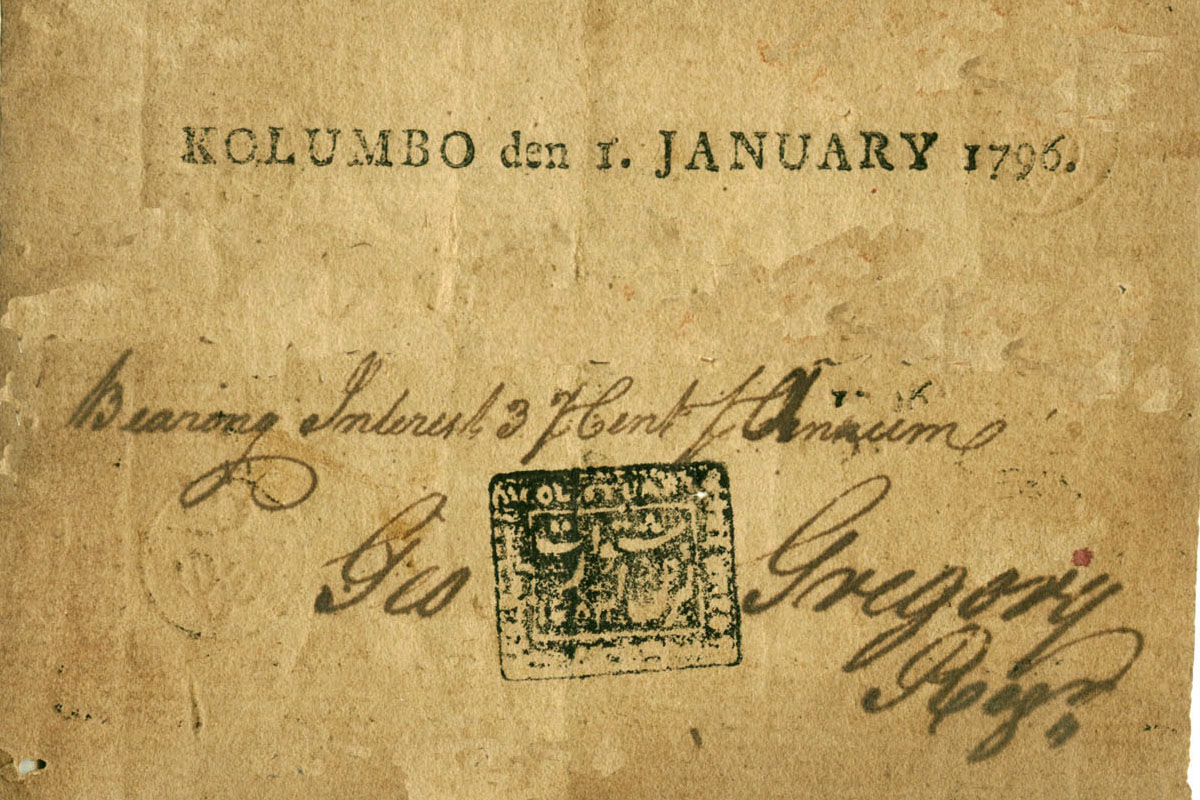 When the British took over the Kredit Brief and Kash noot and endorsed them in
English agreeing to pay 3% Interest.
When the British took over the Kredit Brief and Kash noot and endorsed them in
English agreeing to pay 3% Interest.
The Black Seal 21x18 mm with Arabic Script appears in
the middle of the British signature Geo Gregory / Reg.
George Gregory was Collector for Colombo.
Was not sure if it was part of the Dutch notes,
or the British Endorsement, and why it would have Arabic script.
There appears to be smaller indistinct text around a border of seal as well.
E-mailed to Jan Lingen and
Islamic Coin Group for any insight, comment or reference.
Images of 8 sealing posted below.
Mouse over any image to expand it.
Based on replies I have got so far, given at end of this page,
it has now been Identified as the personal Seal of Colonel James Stuart
who led the British troops to take Ceylon from the Dutch.
At center of image array I give the Persian 'Karnal iStuart' in Arabic Unicode using Nasta'leek Font.
At the SLNS meeting on 2018 March 18th it was read as Surat
 by members who can read Arabic
by members who can read Arabic
The Surat rupee was a trade coin and also used by the Dutch in Ceylon.
Note in Unicode default font in Persian or Urdu looks significantly
different in default Unicode Arabic Naskh font.
سورات.
but close in Persian Nasta'leeq font as
سورات.
The 4 is available in Unicode with the extended Arabic-Indic digits in Nasta'leek Font.
But the 7 needs the default Naskh or the Arabic-Indic digits in Nasta'leek Font.
Date on lower left is
١٧٩۴ 1794
The 4 is in Hyderabad Arabic font (

)
See Surat Silver Rupee
coins
Jan Lingen said in E-mail
Surat is in my opinion not possible.
On the stamp is written Sh-t-w(or u)-r-a-t.
Compare with Surat on the coins and see the difference: See
coin
Well I hope you will be able to find out the correct reading.
Ali Minai in Islamic Coins Group said
It says "Colonel Stewart" with a date.
Colonel Stuart
led the British troops to
take Ceylon from the Dutch.
On 1796 February 15 Van Angelbeek agreed to capitulate and Stuart took possession of Colombo city peacefully.
Jan Lingen said in E-mail
Looking at the seal(s) again, the stamp has become pretty clear.
It is personal seal of Colonel J. Stuart. The document of capitulation
of 15 February 1796 was signed by P.A. Agnew (Adjt. Gen.) and approved
and confirmed by J. Stuart & A.H. Gardner.
On some of the seals you can read on the top border COL.STUART.
The name 'Stuart' is written on the top line; below 'Karnal' or 'Karněl'.
The date seems to be '1794'. From the images shown on
website I can't read 1796. The last digit on all looks like a '4'.
After James Stuart was promoted to colonel he returned to Madras in
1794, he probably got this personal seal made, which he used
afterwards in Colombo.
The use of Arabic (actually Persian or Urdu) in India is not
surprising as much of the correspondence in India, also under British
administration, happened to be in Persian or Urdu.
One is a symbol left of 'karnel', which looks like an 'Alif', and
could be his initial, but so far I have not a satisfactory explanation
for it.
So it looks that the puzzle gets close to be solved.
Ali Minai in Islamic Coins Group said
I can solve the mystery of the extra 'alif'. In fact, it is the first
letter of 'Stuart'. Urdu/Persian do not have the initial 'sX' sound
(where X is some consonant), and words like school, station, etc. are
pronounced as 'iskool', 'istation'. Thus, Stuart is written as
استوارت
Moving the initial alif below the rest of the text is also a common
calligraphic device, often seen on coins and seals. As you also imply,
this seal is more accurately seen as Persian rather than Urdu. Persian
was the official language through most of India in the late 18th
century. Urdu was still an upstart vernacular just coming into its own.
The script on the seals is Nasta'leeq while unicode is in the Naskh
script. Nasta'leeq is the default script for Urdu and the traditional
script for Farsi (though a lot of Farsi stuff is now written in
Naskh). Naskh is a standard Arabic script.
Please send any additional comments or reference to a better image of this seal which may
enable the reading of the Text on the left, right and bottom border.
The Original of capitulation document in Sri Lanka National Archives had no seal.
The other letters from Colonel Stuart were transcribed copies and also had no seals.
I find it interesting that a British officer in 1794 used Arabic Script on his
personal seal as it was the primary language in Mogul India.
Ref:
Used Google Translate and
Transliteration to Arabic Unicode and then
to HTML entities.
Arabic Unicode uses Naskh Font as default, while Persian uses Nasta'leek Font.
Both share the same Arabic Unicode-ranges in HEX: U+0600-06FF; U+0750-077F; U+FB50-FDFF; U+FE70-FEFF;
The slight difference between Arabic, Persian and Urdu and the difference between Naskh and Nasta'leek Fonts are illustrated below.
| English | Stuart Colonel
| Arabic Naskh | قرنل ستيوارت
| | Persian Naskh | کرنل استوارت
| | Persian Nasta'leeq | کرنل استوارت
| | Urdu Nasta'leeq | کرنل سٹوارت
| |
Using default Unicode Arabic Naskh font digits
| 0 | 1 | 2 | 3 | 4 | 5 | 6 | 7 | 8 | 9
|
| Arabic Indic Naskh | ٠ | ١ | ٢ | ٣ | ٤ | ٥ | ٦ | ٧ | ٨ | ٩
|
| Arabic Indic extended Naskh | ۰ | ۱ | ۲ | ۳ | ۴ | ۵ | ۶ | ۷ | ۸ | ۹
|
Using Persian Arabic Nasta'leeq font digits
| 0 | 1 | 2 | 3 | 4 | 5 | 6 | 7 | 8 | 9
|
| Arabic Indic Nasta'leeq | ٠ | ١ | ٢ | ٣ | ٤ | ٥ | ٦ | ٧ | ٨ | ٩
|
| Arabic Indic extended Nasta'leeq | ۰ | ۱ | ۲ | ۳ | ۴ | ۵ | ۶ | ۷ | ۸ | ۹
|
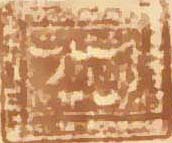
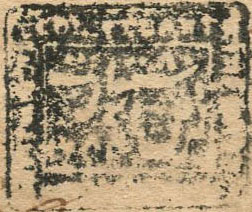
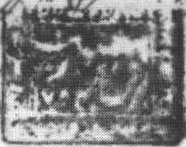
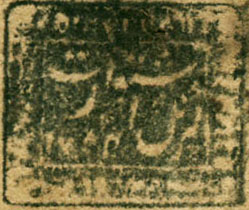
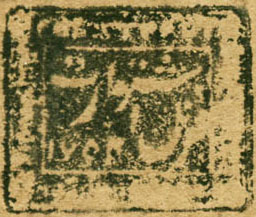
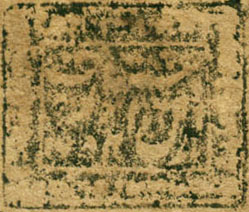
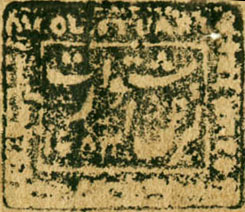
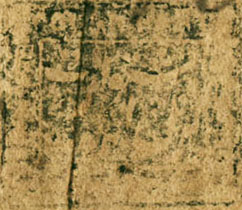
 When the British took over the Kredit Brief and Kash noot and endorsed them in
English agreeing to pay 3% Interest.
When the British took over the Kredit Brief and Kash noot and endorsed them in
English agreeing to pay 3% Interest.








 by members who can read Arabic
by members who can read Arabic